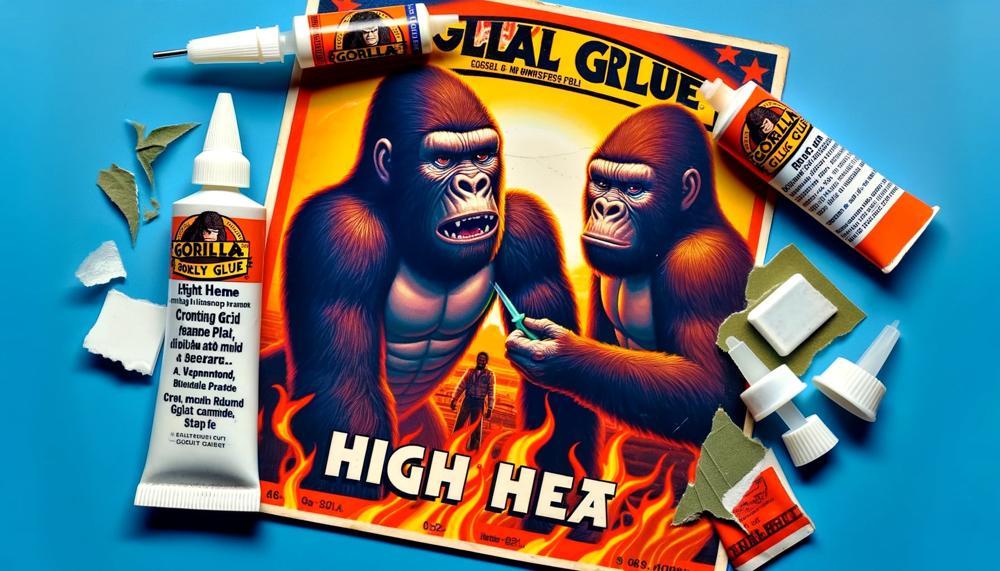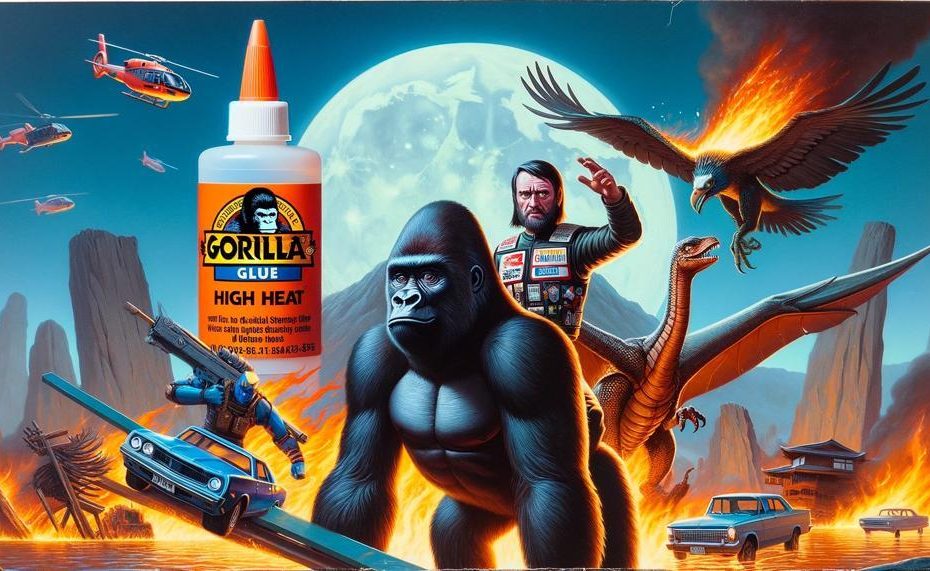When it comes to fixing things around the house or embarking on a DIY project, the bond you choose to hold it all together is crucial. Enter Gorilla Glue – renowned for its strength and versatility, it’s the go-to adhesive for an array of materials. But what happens when your repair is subjected to the unforgiving test of high temperatures? Can gorilla glue withstand high heat?
Gorilla Glue is not designed to withstand continuous high temperatures and may degrade or lose its adhesive properties when exposed to heat. Gorilla Super Glue Gel can work in temperatures as high as 200°-220°F, but too much exposure to extreme heat can compromise the strength of the bond.
So let’s turn up the heat and get to the core of Gorilla Glue’s heat resistance.
Table of Contents
- 1 How Does Gorilla Glue React to Heat?
- 2 Types of Gorilla Glue and Their Heat Resistance
- 3 Can Gorilla Glue Withstand Normal Household Temperatures?
- 4 Can Gorilla Glue Withstand Intermittent Exposure to High Heat?
- 5 Can Gorilla Glue Withstand Continuous Exposure to Extreme Heat?
- 6 Alternatives for Applications Requiring Constant Heat Resistance
- 7 Factors to Consider When Using Gorilla Glue in High Heat Situations
- 8 Recommended Usage Guidelines for Maximum Effectiveness
- 9 Conclusion
How Does Gorilla Glue React to Heat?
Gorilla Glue, a polyurethane-based adhesive, is lauded for its robustness and versatility. It’s formulated to tackle a wide array of bonding tasks, from casual crafts to demanding home repairs.
Its unique composition enables it to endure temperatures from the frosty lows of -40°F to the sweltering highs of 200°F (-40°C to 93°C), which speaks to its impressive thermal stability.

| Temperature Range | Effect on Gorilla Glue | Recommended Action |
| -40°F to 200°F (-40°C to 93°C) | Stable bonding capacity | No special measures required |
| Above 200°F (93°C) | Potential weakening of polymeric chains | Consider alternative high-temperature adhesives |
| During Curing Process | Accelerated curing may weaken bond | Maintain recommended temperature range |
In essence, Gorilla Glue demonstrates admirable resistance to heat within its specified range. However, exposing the adhesive to temperatures surpassing 200°F (93°C) or to rapid temperature changes could diminish its bonding capabilities.
It’s essential to match the adhesive to the task at hand, bearing in mind both the temperature tolerance of the glue and the materials it’s intended to unite. For enduring high-heat applications, specialized adhesives might be the ticket.
Types of Gorilla Glue and Their Heat Resistance
Gorilla Glue is renowned for its robust bonding capabilities, particularly when it comes to withstanding high temperatures. Below is a breakdown of the types of Gorilla Glue and their heat resistance:
| Type of Gorilla Glue | Temperature Range | Heat Resistance Features |
| Original Gorilla Glue | -40°F to 200°F (-40°C to 93°C) | Expands to form a strong bond; suitable for various temperatures and surfaces. |
| Super Glue Gel | High-heat specific | Designed for enduring elevated temperatures; ideal for quick fixes. |
| Epoxy Gorilla Glue | Up to 300°F or higher | Offers a resilient bond under intense heat; suitable for demanding applications. |
Each glue’s unique formula allows it to perform exceptionally under heat stress. The Original Gorilla Glue’s moisture-activated expansion, Super Glue Gel’s heat-specific design, and Epoxy’s high-temperature resilience ensure that there’s a Gorilla Glue suitable for nearly any task that involves heat exposure.
However, it’s pivotal to check each product’s specifications for precise temperature tolerances and ensure that the materials being bonded can also endure the heat.
Can Gorilla Glue Withstand Normal Household Temperatures?
Absolutely, Gorilla Glue is a powerhouse when it comes to enduring the hustle and bustle of normal household temperatures.
| Temperature Range | Gorilla Glue Performance |
| Up to 200°F | Stands firm, no sweat |
| Up to 220°F (short periods) | Hangs tight, but not forever |
| Constant high heat (>220°F) | Throws in the towel |
So, for those household repairs away from the heat of battle, Gorilla Glue’s your trusty steed.
Can Gorilla Glue Withstand Intermittent Exposure to High Heat?
Gorilla Glue can take the heat to some degree, holding fast up to about 200 degrees Fahrenheit. It’s tough stuff, but like most things, it has its limits. If the mercury climbs higher, it’ll start to lose its moxie.
Here’s the rub: constant high heat is the arch-nemesis of Gorilla Glue’s adhesive prowess.
Maximum Temperature for Gorilla Glue:
Gorilla Glue keeps its grip tightest below 200°F. As the temperature tips over that, its bond begins to loosen. Here’s a quick look at the temperature range:
| Temperature | Adhesive Integrity | Notes |
| 0°F – 150°F | Sturdy and reliable | Optimal performance range |
| 150°F – 200°F | Some weakening | Adhesive begins to soften |
| Over 200°F | Significant weakening | Integrity compromised, especially if heat is constant |
To cut to the chase, Gorilla Glue is a bit of a heavyweight when it comes to sticking things together, but don’t push your luck with high heat. If you’ve got a project that’s going to get toasty, you might want to look for a glue that’s made to handle the heat.
Can Gorilla Glue Withstand Continuous Exposure to Extreme Heat?
Gorilla Glue, while robust and heat-resistant, has its bounds. It’s crafted to cope with a temperature spectrum from a nippy -40°F up to a toasty 200°F.
Push it past that, and you’re wading into risky waters where its adhesive prowess might falter. Let’s talk turkey about what could go awry if you ask too much of it in scorching conditions.
Potential Risks and Limitations:
- Degradation of Bond Strength: The molecular integrity that gives Gorilla Glue its clout could start to buckle under extreme heat that’s beyond its comfort zone.
- Durability Concerns: Sure, it’s tough as nails on a normal day, but continuous heat might lead to a reduction in its fabled impact resistance.
- Curing Complications: The glue needs to cure just right, and if it’s baking in the oven of relentless heat, that perfect set could be compromised.
- Application Mishaps: It demands a bit of elbow grease to apply correctly – the right prep, technique, and time. Skimp on these in high heat, and it’s a recipe for a weak bond.
- Uncharted Territory: Venturing above 200°F? Gorilla Glue isn’t your huckleberry. It’s untested waters, and you’d best consult the pros or consider a specialist adhesive.
| Risk Factor | Consequence | Condition |
| Heat Threshold Exceeded | Weakened Adhesive Strength | >200°F (93°C) |
| Continued Heat Exposure | Reduced Impact Resistance | Long-term High Heat |
| Suboptimal Curing | Compromised Bonding | High Heat During Curing |
| Improper Application | Weak Bond Formation | Incorrect Prep/Technique/Time |
| Specialized Requirements | Need for High-Temperature Adhesive | Use in Extreme Heat Conditions |
Remember, if you’re hitting the high notes of the thermometer, a test run isn’t just wise; it’s essential. And when the heat’s cranked up, it may be time to shop around for an adhesive that’s made for those fiery feats.
Alternatives for Applications Requiring Constant Heat Resistance
For applications that require constant heat resistance beyond the threshold of Gorilla Glue, several alternatives provide robust performance.
| Adhesive Type | Temperature Resistance | Applications |
| High-Temp Epoxies | Up to 300°F (149°C) and above | Automotive, aerospace, industrial bonding |
| Ceramic Adhesives | Up to 2500°F (1371°C) | Exhaust systems, furnaces, electrical components |
| Phenolic/Polyimide Adhesives | Up to 500°F (260°C) and higher | Circuit boards, heat shields, aerospace components |
| Mechanical Fasteners | Varies with material | Construction, metalwork, heavy machinery |
Prepping the surface properly, applying with savvy, and checking that materials are mates for the job are key to a steadfast fix.
Factors to Consider When Using Gorilla Glue in High Heat Situations
When using Gorilla Glue in scenarios where the heat is as relentless as the midday sun, one must tread with caution. Below are the potential risks and limitations to bear in mind:
| Risk/Limitation | Detail | Precaution/Note |
| Toxic Fumes | Overheating Gorilla Glue releases hazardous fumes | Ensure good ventilation |
| Fabric Damage | May ruin delicate fabrics like silk, wool, velvet | Use with caution on sensitive materials |
| Synthetic Fabric Test | Potential adverse reactions on synthetic fabrics | Conduct a small area test before full application |
| Curing Process | High heat can alter adhesive curing | Follow the manufacturer’s instructions for temperature ranges |
| Alternative Adhesives | Some situations require heat-resistant adhesives | Consider adhesives specifically for high heat applications |
Recommended Usage Guidelines for Maximum Effectiveness
Surface Preparation
Before you start:
- Ensure surfaces are clean, dry and free from oil, grease and dust.
- For optimum adhesion, roughen smooth surfaces prior to application.
Applying the Adhesive
Application:
- Apply a thin layer; too much glue can hinder the setting process.
- For non-porous materials, a light spritz of water can aid in curing.
Clamping:
- Clamp surfaces together firmly to ensure the bond sets correctly.
- Leave clamped for 1-2 hours; full cure is achieved in 24 hours.
High Heat Tolerance
- Temperature range: Gorilla Glue can handle up to 200°F (93°C).
- Continuous exposure: Avoid prolonged exposure above 180°F (82°C) to maintain bond strength.
Alternative Options for Higher Temperatures
- Gorilla Epoxy: Withstands up to 300°F (149°C).
- Silicone-based adhesives: Suitable for up to 600°F (315°C).
Safety Measures
- Use in well-ventilated areas.
- Wear gloves to prevent skin contact.
- Follow all instructions on the product label.
| Step | Action | Note |
| Clean | Remove debris and contaminants. | Essential for a secure bond. |
| Roughen | Create a textured surface. | Improves grip for the adhesive. |
| Apply | Spread a modest amount of glue. | Excess can prevent curing. |
| Clamp | Press and hold surfaces. | 1-2 hours for initial set. |
| Cure | Allow 24 hours for full cure. | Important for maximum strength. |
| High Heat | Be wary of temperatures over 180°F. | Seek alternatives for extreme heat. |
Remember: Always keep a keen eye on safety. Gloves are your friends, just as clean air is. Stay safe, stay smart, and your project should come together without a hitch.
Conclusion
In conclusion, Gorilla Glue is a dependable glue for a variety of home and do-it-yourself tasks because of its reputation for strength and adaptability, which includes its capacity to withstand high temperatures.
For a strong binding on a variety of surfaces and conditions, the Original Gorilla Glue has a standard temperature range of -40°F to 200°F (-40°C to 93°C). When exposed to temperatures over this range, it’s crucial to understand the constraints.
Extreme or continuous heat may weaken the adhesive’s integrity, while brief bursts up to 220°F can be OK. Super Glue Gel and Epoxy Gorilla Glue versions, made especially for greater temperatures, would be a better fit for such high-heat applications.
Recall that the total bond stability is also highly dependent on the heat tolerance of the substrate materials. You may get the greatest results by using Gorilla Glue within the approved temperature ranges and by applying it correctly.
It’s usually a good idea to study the product specs and take into consideration an adhesive designed to withstand high temperatures when it comes to individuals who find themselves in difficult repair or creation scenarios.






